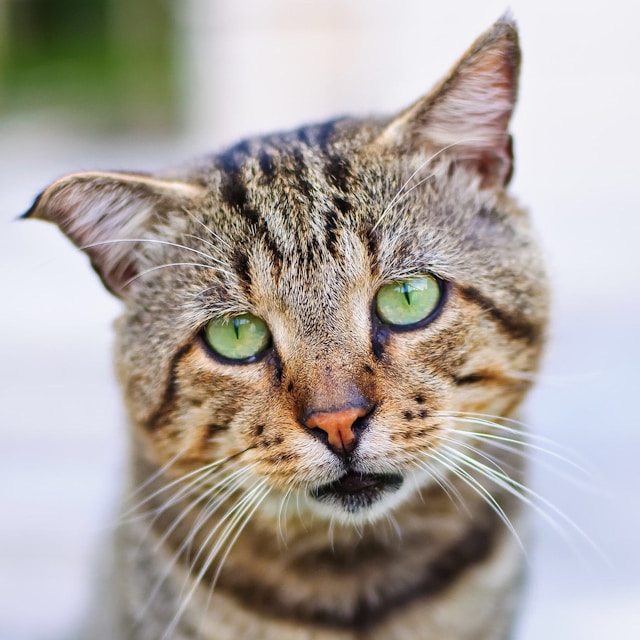Ocicat

| OFFICIAL NAME | Ocicat |
| COMMON NAME | Ocicat |
| PET HEIGHT | 9 to 11 inches |
| PET WEIGHT | 6 to 15 pounds |
| LIFESPAN | 12 to 18 years |
| GOOD WITH | cats, children, dogs, families, seniors |
| TEMPERAMENT | affectionate, sociable |
| INTELLIGENCE | high |
| SHEDDING AMOUNT | seasonal |
| PLAYFULNESS | high |
| ENERGY LEVEL | active |
| VOCAL LEVEL | when necessary |
| COAT LENGTH | short |
| COLORS | chocolate/brown/sable, cinnamon, fawn, lavender/silver, lilac |
| PATTERNS | bi-color, tabby |
| OTHER TRAITS | easy to groom, easy to train, friendly toward humans, friendly toward other pets, friendly toward strangers, good for first-time pet owners, good lap cat, strong loyalty tendencies, tolerates being picked up |
The Ocicat is a unique and eye-catching pet with its striking spotted coat. These cats are known for being very social and intelligent and often exhibit behaviors likened to dogs.
Appearance
Ocicats are easily recognizable thanks to their striking coats adorned with brown or gold thumb-shaped spots. While some ocicat kittens may deviate with solid colors, pointed coats, or classic tabby patterns, the breed is predominantly known for these distinct markings. They come in twelve color variations, including tawny, chocolate, cinnamon, blue, lavender, and fawn. Ocicats are muscular and agile, typically more significant than your average house cat, with males weighing up to 15 pounds. They have wedge-shaped heads, large oval paws, and triangular ears that sit at a 45-degree angle.
Personality
The Ocicat is known for being highly social and enjoys interacting with humans. They are generally friendly towards all family members and visitors. Still, they often develop a strong bond with one person in their household, whom they may follow closely.
Marilyn Krieger, a certified cat behavior consultant from San Francisco, describes Ocicats as highly active, intelligent, and social creatures. They must have interactive toys and plenty of interaction with their human companions. Ocicats are easily trainable and can learn tricks like responding to their names, sitting, staying, and even fetching. They are quick learners who can grasp commands and the context behind them.
Due to their lineage from Abyssinian and Siamese cats, Ocicats possess a vibrant personality. They are known to be quite vocal like their Siamese ancestors, though generally not as loud.
Living Needs
Ocicats are incredibly versatile. They make excellent companions for RV travelers and are content in various urban or rural environments as long as they receive enough social interaction. They love climbing, so providing them with opportunities to ascend will keep them happy. A cat tree, hammock, or wall-mounted shelves are ideal for their enjoyment.
According to Krieger, these cats are great for families and are gentle with children. They also get along well with other animals, including dogs, especially if they've grown up together. Due to their social nature, Ocicats in single-pet households might experience separation anxiety if left alone for extended periods. Krieger suggests considering adopting a bonded pair of Ocicats to keep them company.
Care
"This breed sheds enough that it's not considered hypoallergenic, but you can manage it with a weekly brushing. Bathing isn't necessary unless you're showing them. If you are, use specific shampoos to enhance their natural coat colors: bronze-tone for brown, chocolate, and cinnamon spotted ocicats, pearl-tone for blue, lilac, and fawn ocicats, and whitening shampoo for silver cats. Like all cats, ocicat owners should keep their cat's nails trimmed and their litter box clean."
Health
Ocicats generally enjoy good health and can live between 12 to 18 years. However, there are some health issues to watch out for, including liver or renal amyloidosis, pyruvate kinase deficiency, and hypertrophic cardiomyopathy.
Dr. Lin Kauffman from Prairie View Animal Hospital in Iowa warns that when cats are selectively bred for specific traits, it can increase the risk of these health problems. "With a smaller gene pool, genetic diseases can become more common," she explains.
Hypertrophic cardiomyopathy (HCM), a condition in which the heart muscle thickens, is the most prevalent heart disease in cats, including Ocicats. A heart ultrasound (echocardiogram) can diagnose HCM, which can eventually lead to heart failure. According to Dr. Michelle Beck from Backlund Animal Clinic in Nebraska, cats diagnosed with HCM typically have a life expectancy of about a year after diagnosis.
Amyloidosis is another concern among Ocicats, where amyloid protein deposits can affect organs like the kidneys or liver, leading to dysfunction and organ failure.
Pyruvate kinase deficiency, which causes anemia due to a lack of a key enzyme in red blood cells, is also a condition Ocicats can inherit.
Keeping an eye out for these conditions and regular veterinary check-ups can help manage and mitigate these health risks in Ocicats.
Exercise Requirements
The Ocicat is a lively and curious cat that loves staying active both physically and mentally. They do well in apartments with enough room to move around and play. It's even better to provide them with a house with a fenced yard! Regardless of where they live, they'll thrive with plenty of toys and accessories, such as a large cat tree, to keep them entertained and happy, especially when you're not around.
Training
Ocicat cats are known for their impressive knack for learning tricks. They're smart enough to master tasks like responding to their name, sitting for treats, walking on a leash, and even fetching. Teaching them tricks can be just as enjoyable for you as it is for your cat!
History
In 1964, an American named Virginia Daly took on a challenge from a friend to create a cat that combined Abyssinian and Siamese traits. Her initial attempt resulted in a kitten with pointed Siamese features. However, a subsequent litter unexpectedly produced a kitten covered in unique spots, resembling a wild ocelot. Daly's daughter named him "Ocicat."
Despite Tonga, the first ocicat, being neutered and given as a pet, subsequent litters continued to produce spotted kittens. Daly then bred these hybrids back to Siamese cats, eventually producing fully spotted litters. Other breeders followed suit, leading to the official recognition of the Ocicat breed by the Cat Fanciers' Association for the championship in 1987.
Fun Facts
In a YouTube video from GQ Magazine's "Most Expensive Sh*t" series, rapper 2 Chainz showcases kittens, including ocicats valued at $3,000 each, totaling over $165,000. Additionally, Ocicats starred in a beloved episode of Animal Planet's "Too Cute!" series.
Get insurance plans with wide-ranging coverage options













